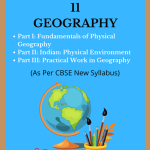NCERT Class 11 Geography Chapter 5 Minerals and Rocks Solutions to each chapter is provided in the list so that you can easily browse through different chapters NCERT Class 11 Geography Chapter 5 Minerals and Rocks and select need one. NCERT Class 11 Geography Chapter 5 Minerals and Rocks Question Answers Download PDF. NCERT Geography Class 11 Solutions.
NCERT Class 11 Geography Chapter 5 Minerals and Rocks
Also, you can read the NCERT book online in these sections Solutions by Expert Teachers as per Central Board of Secondary Education (CBSE) Book guidelines. CBSE Class 11 Geography Solutions are part of All Subject Solutions. Here we have given NCERT Class 11 Geography Part I: Fundamentals of Physical Geography, Part II: Indian: Physical Environment, Part III: Practical Work in Geography. NCERT Class 11 Geography Chapter 5 Minerals and Rocks Notes, NCERT Class 11 Geography Textbook Solutions for All Chapters, You can practice these here.
Minerals and Rocks
Chapter: 5
GEOGRAPY [ PART – I ]
TEXTUAL QUESTIONS ANSWERS
MULTIPLE CHOICE QUESTIONS
1. Which one of the following are the two main constituents of granite?
(a) Iron and nickel.
(b) Iron and silver.
(c) Silica and aluminium.
(d) Iron oxide and potassium.
Ans. (c) Silica and aluminium.
2. Which one of the following is the salient feature of metamorphic rocks?
(a) Changeable.
(b) Quite.
(c) Crystalline.
(d) Foliation.
Ans. (a) Changeable.
3. Which one of the following is not a single element mineral?
(a) Gold.
(b) Silver.
(c) Mica.
(d) Graphite.
Ans. (c) Mica.
4. Which one of the following is the hardest mineral?
(a) Topaz.
(b) Diamond.
(c) Quartz.
(d) Feldspar.
Ans. (b) Diamond.
5. Which one of the following is not a sedimentary rock?
(a) Tillite.
(b) Borax.
(c) Breccia.
(d) Marble.
Ans. (d) Marble.
6. The material which form the earth crust:
(a) Rock.
(b) Mineral.
(c) Clay.
(d) Limestone.
Ans. (a) Rock.
7. A hot sticky molten material is:
(a) Magma.
(b) Lava.
(c) Clay.
(d) Mineral.
Ans. (a) Magma.
8. Limestone during metamorphism changes into:
(a) Marble.
(b) Clay.
(c) Guists.
(d) None.
Ans. (a) Marble.
9. Clay is changed into:
(a) Slate.
(b) Marble.
(c) Granite.
(d) None.
Ans. (a) Slate.
10. Granite is a /an:
(a) Igneous rock.
(b) Sedimentary rock.
(c) Metamorphic rock.
(d) None.
Ans. (a) Igneous rock.
11. Which of the following is not among the eight elements?
(a) Oxygen and Silicon.
(b) Aluminum and Iron.
(c) Calcium and Sodium.
(d) Mica and Granite.
Ans. (d) Mica and Granite.
12. Which of the following is not an example of metamorphic rocks?
(a) Slate.
(b) Marble.
(c) Limestone.
(d) Schist.
Ans. (c) Limestone.
13. Which mineral group is abundantly found in the earth’s crust?
(a) Mica group.
(b) Feldspar group.
(c) Oxide group.
(d) Silicate group.
Ans. (b) Feldspar group.
14. Which one of the following is the salient feature of metamorphic rocks?
(a) Changeable.
(b) Quite.
(c) Crystalline.
(d) Foliation.
Ans. (a) Changeable.
15. Which one of the following are the hardest minerals?
(a) Topaz.
(b) Diamond.
(c) Quartz.
(d) Feldspar.
Ans. (b) Diamond.
16. Which of the following is a ferrous mineral?
(a) Copper.
(b) Aluminum.
(c) Iron Ore.
(d) Tin.
Ans. (c) Iron Ore.
17. A non-metallic mineral in the following minerals is
(a) silver.
(b) copper.
(c) zinc.
(d) coal.
Ans. (d) coal.
18. Igneous rocks are
(a) primary rocks.
(b) secondary rocks.
(c) tertiary rocks.
(d) soft rocks.
Ans. (a) primary rocks.
19. Which one of the following is the component of sand and granite?
(a) Amphibole.
(b) Quartz.
(c) Pyroxene.
(d) Mica.
Ans. (b) Quartz.
20. The most abundant rocks found on the earth’s crust are
(a) igneous rocks.
(b) sedimentary rocks.
(c) metamorphic rocks.
(d) granite rock.
Ans. (a) igneous rocks.
21. Rocks that were originally either sedimentary, igneous, or metamorphic and have been changed further by heat and pressure are called:
(a) Volcanic.
(b) Sedimentary.
(c) Metamorphic.
(d) None of the above.
Ans. (c) Metamorphic.
22. Which one of the following is not a sedimentary rock?
(a) Tillite.
(b) Borax.
(c) Breccia.
(d) Marble.
Ans. (d) Marble.
23. Iron is a
(a) ferrous metal.
(b) non-ferrous metal.
(c) precious metal.
(d) non-precious metal.
Ans. (a) ferrous metal.
24. What kind of colour does Pyroxene consist of?
(a) Green.
(b) Black.
(c) Both (a) and (b).
(d) None of the above.
Ans. (d) None of the above.
25. The minerals that do not contain metal contend are known as
(a) precious minerals.
(b) ferrous minerals.
(c) non-metallic minerals.
(d) non-ferrous minerals.
Ans. (c) non-metallic minerals.
26. The parent material of soils is derived from
(a) igneous rocks.
(b) metamorphic rocks.
(c) sedimentary rocks.
(d) biological action.
Ans. (c) sedimentary rocks.

Hi! my Name is Parimal Roy. I have completed my Bachelor’s degree in Philosophy (B.A.) from Silapathar General College. Currently, I am working as an HR Manager at Dev Library. It is a website that provides study materials for students from Class 3 to 12, including SCERT and NCERT notes. It also offers resources for BA, B.Com, B.Sc, and Computer Science, along with postgraduate notes. Besides study materials, the website has novels, eBooks, health and finance articles, biographies, quotes, and more.




